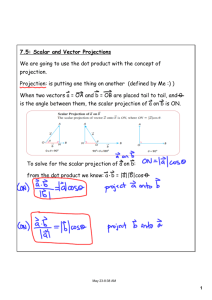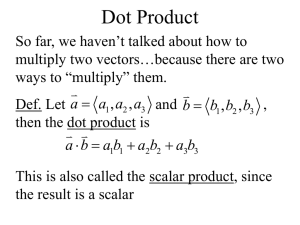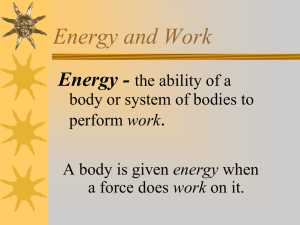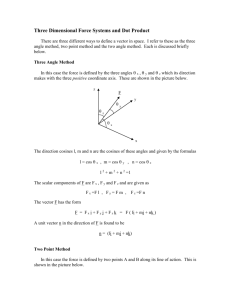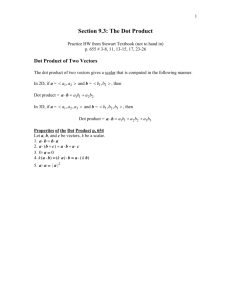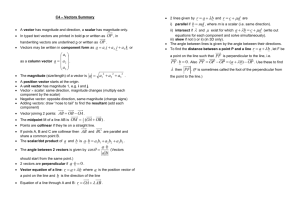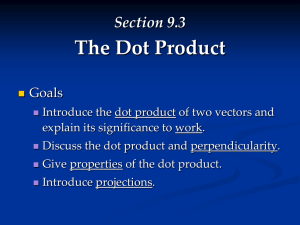The dot product of two vectors.
advertisement
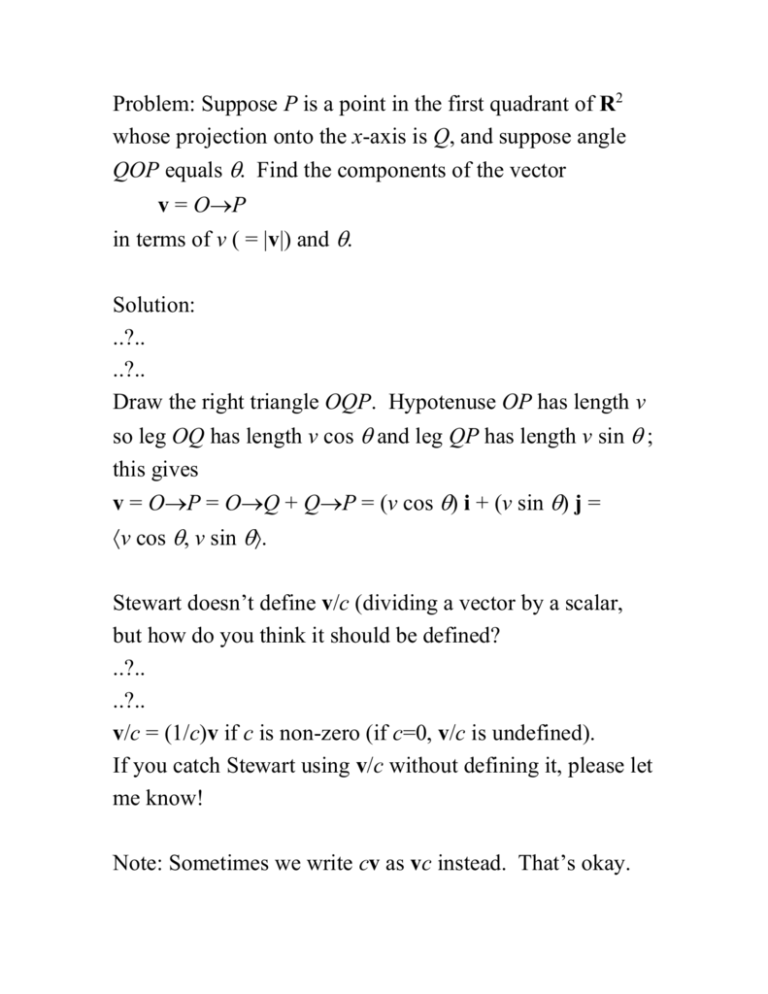
Problem: Suppose P is a point in the first quadrant of R2 whose projection onto the x-axis is Q, and suppose angle QOP equals . Find the components of the vector v = OP in terms of v ( = |v|) and . Solution: ..?.. ..?.. Draw the right triangle OQP. Hypotenuse OP has length v so leg OQ has length v cos and leg QP has length v sin ; this gives v = OP = OQ + QP = (v cos ) i + (v sin ) j = v cos , v sin . Stewart doesn’t define v/c (dividing a vector by a scalar, but how do you think it should be defined? ..?.. ..?.. v/c = (1/c)v if c is non-zero (if c=0, v/c is undefined). If you catch Stewart using v/c without defining it, please let me know! Note: Sometimes we write cv as vc instead. That’s okay. But we don’t write vw if v and w are both vectors; it’s not defined. (Later we’ll learn not one but TWO ways to multiply two vectors v and w, but neither of them is written as “vw”.) Stewart makes use of the fact that |cv| is equal to |c| |v|. Is |v+w| equal to |v| + |w|? ..?.. ..?.. Sometimes, but not always! E.g., ..?.. ..?.. |i+i| = 2 = |i|+|i|, but |i+j| = sqrt(2) ≠ 2 = |i|+|j|; also |i–i| = |0| = 0 ≠ 2 = |i| + |–i|. Section 10.3: The dot product How many of you have seen the dot product before in two dimensions? How many of you have seen the dot product before in three dimensions? Main ideas? ..?.. ..?.. Algebraic and geometric formulations of the dot product The relationship between the sign of ab and the angle between a and b Orthogonal vectors Vector and scalar projections The dot product (aka inner product or scalar product) of two vectors is a scalar: Algebraic formulation: ..?.. ..?.. a1, a2, a3b1, b2, b3 = a1b1 + a2b2 + a3b3 Geometric formulation: ..?.. ..?.. a b = |a| |b| cos where is the angle between the vectors a and b. Combining these two formulas, we get a way to compute the angle between two vectors (or at least its cosine): use the first formula to compute the dot product, and then plug this into the second formula to solve for cos . Also: If a and b are non-zero vectors, then a b is positive, zero, or negative according to whether the angle is acute, right, or obtuse, respectively. In particular, if a and b are non-0 vectors, a b = 0 if and only if a is perpendicular to b. Some important formulas for the dot product appear in the middle of page 551. Let’s prove one of them. Prove (ca) b = c(a b): ..?.. ..?.. Express each side of the equation in terms of coordinates: LHS: (ca1, a2, a3)b1, b2, b3 = ..?.. ..?.. ca1, ca2, ca3b1, b2, b3 = ..?.. ..?.. ca1b1 + ca2b2 + ca3b3. RHS: c(a1, a2, a3b1, b2, b3) = ..?.. ..?.. c(a1b1 + a2b2 + a3b3) = ..?.. ..?.. ca1b1 + ca2b2 + ca3b3. So LHS = RHS, as claimed. Of the properties of the dot product listed by Stewart, Property 5 (“0 a = 0”) is the easiest to prove, but in some ways the most confusing; it seems to be saying that the vector 0 is perpendicular to every other vector! Typically the word “perpendicular” is reserved for nonzero vectors (since 0 doesn’t point in any particular direction), though Stewart disagrees with me on this. We say two vectors are orthogonal if and only if their dot product is 0. So Property 5 says that 0 is orthogonal to every vector (including itself). Projections: [Have the students geometrically identify the scalar projection of b onto a (written compa b) and the vector projection of b onto a (written proja b), in both the acute-angle case and obtuse-angle case.] What’s the relationship between them? ..?.. ..?.. proja b equals compa b times the unit vector in the direction of a. Also, compa b equals either the magnitude of proja b or its negative, according to whether the angle between a and b is acute or obtuse. As a special case, if a = 1,0 (or any multiple of 1,0), then the scalar projection of b onto a is just the xcomponent of b; likewise, if a = 0,1 (or any multiple of 0,1), then the scalar projection of b onto a is just the ycomponent of b. [Have the students draw compb a and projb a, to see how they differ from compa b and proja b.] compa b = |b| cos (see Stewart), and a b = |a| |b| cos , so we have a b = |a| compa b and compa b = (a b) / |a|. Stewart gives handy formulas for projections in the middle of page 554, in terms of the dot-product. Problem 1: Which of the following expressions are meaningful? (a b) c : (a b) c : |a| (b c) : a (b + c) : ab+c: |a| (b + c) : Important fact to keep in mind: For any vector v, we have vv = … ..?.. ..?.. the length of v, squared. So |v| = sqrt(vv). Economics example (Problem 12): A street vendor sells a hamburgers, b hot dogs, and c soft drinks on a given day. He charges $2 for a hamburger, $1.50 for a hot dog, and $1 for a soft drink. If A = a, b, c and P = 2, 1.5, 1, what is the (economic) meaning of the dot product A P? ..?.. ..?.. The vendor’s revenue. Physics example: When a force-vector F causes an object to be displaced by the displacement vector D, the work done is … ..?.. ..?.. F D (or D F). (Note that this is negative when the angle is obtuse, or when F and D point in opposite directions; e.g., when I lower a heavy object, I’m doing negative work on it.) Suppose a b = a c, with a 0. Can I conclude that b = c? ..?.. ..?.. No; e.g., j 0 = j i but 0 i. Also: i j = i k but j k. Suppose a b = a c 0, with a 0. Can we conclude that b = c? Think about this for next time!
